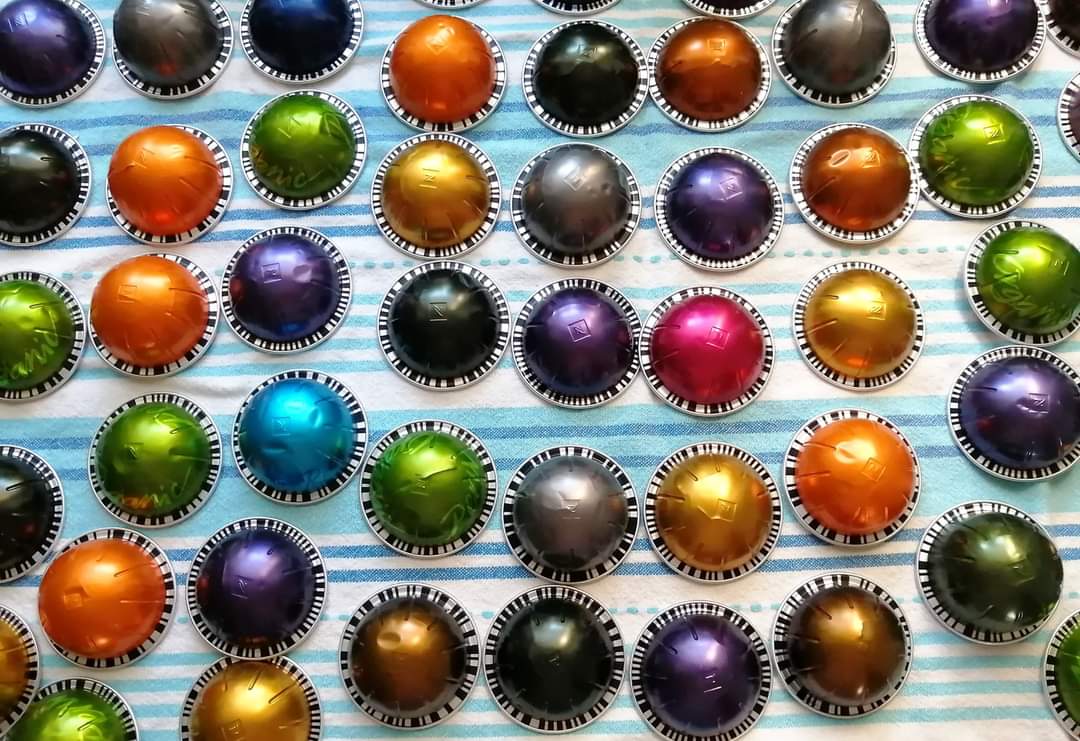
If you are not a fan of arts and crafts, be a fan of your own life!
How did you come up with the idea of making lamps?
Magdolna Mohácsek: I often saw how people use Nespresso coffee capsules for making coffee and throw them away afterward. One day I thought, why not make something interesting out of it?
I wanted to try out an environment-friendly idea. At first, I started making jewelry, but then I collected more and more capsules and looked for more significant projects. I didn't want to use, for example, wood or paint wood or other things. I decided to make the lampshades. This work relaxing, and I do it as a hobby besides my day job. I don't have much spare time, and I primarily work on weekends, in the winter, when I go out less and stay home in the evenings.
Where do you find all the materials for the lamps?
Magdolna Mohácsek: I asked my friends around and posted calls on the Internet and Facebook that I was looking to collect for them. I have many stocks now and don't need help making the micro-elements for each lampshade because the material is light and flexible. So, it's easy. But if you must do these repetitive movements for hours, it will be challenging.
How do you design each object? Do you change color? Who makes the frame for the lampshade?
Magdolna Mohácsek: Every taste of Nespresso coffee has a different original color, so I don't paint them on the outside. But I paint them inside. There are many appealing colors, and I enjoy working with them. Also, I discovered how to fix all elements and create different constructions.
There are many ways to give a new purpose to using coffee capsules. At first, I looked for information on the Internet to prospect recycling ideas, then I developed my own work.
I learned how many other people, for example, from Switzerland or Italy, do the same. Primarily women, and I don't know why. During screening web pages, I saw no men making such objects. Creating lamps with used coffee capsules may not cause many emotions in men, and they probably express their creativity differently. Creating lampshades is similar to hand weaving, which historically has been done by both men and women.
For me, the main idea of manufacturing is relaxation and meditation. I'm alone with my thoughts, and I'm working manually. It's fun! If I had to do it eight hours per day, it would be more hard work. And it wouldn't be as enjoyable as it is now. Also, I'm glad and happy that my family supports me.

Is recycler-art popular in Romania? Are people ready to buy products from coffee capsules?
Magdolna Mohácsek: Let's speak about the basic idea of recycling waste. So many understand what it means and why we need a more ecological lifestyle. People like to see the manufacturing process, and they appreciate design. I know a few projects around which are based on recycling ideas. But only a few people do such things as I do in Romania.
What are people saying about your lamps?
The first reaction: 'Lamps and jewelry from coffee capsules? Wow... This is unbelievable'. My customers are ordinary people. When they come to the marketplace, they are surprised when I talk about materials. And you asked me, too: 'Is it ceramic or leather?' Customers are also interested in the crafted process. I publish photos and videos on the FB page, but also I understand that recycling art today is not the primary need of every person.
Is recycling art interesting for business? For example, for the owners of niche hotels or restaurants?
Magdolna Mohácsek: The hotels should refrain from investing money in recycling objects. This business is focused on the flow of people. It is closely related to the need to create a unique atmosphere understandable to the majority and preferably for a long time. Experimental things require a different approach. On the other hand, I only make products in small quantities myself, only if they are needed.
***
FACTS: Since the early 1950s, some 8.3 billion tonnes of plastic have been produced worldwide. Around 60% of this has become waste and gone to landfills or ended up in the environment. Plastic bottles, bottle caps, food packaging film, plastic bags, straws, and stirrers are among the most common plastic waste streams.
Text: Yuliya Golodnikova




